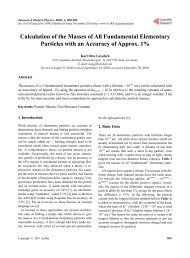Encoding multiple unnatural amino acids via evolution of a ...
Encoding multiple unnatural amino acids via evolution of a ...
Encoding multiple unnatural amino acids via evolution of a ...
You also want an ePaper? Increase the reach of your titles
YUMPU automatically turns print PDFs into web optimized ePapers that Google loves.
Vol 464 | 18 March 2010 |doi:10.1038/nature08817<br />
<strong>Encoding</strong> <strong>multiple</strong> <strong>unnatural</strong> <strong>amino</strong> <strong>acids</strong> <strong>via</strong><br />
<strong>evolution</strong> <strong>of</strong> a quadruplet-decoding ribosome<br />
Heinz Neumann 1 *, Kaihang Wang 1 *, Lloyd Davis 1 , Maria Garcia-Alai 1 & Jason W. Chin 1<br />
The in vivo, genetically programmed incorporation <strong>of</strong> designer<br />
<strong>amino</strong> <strong>acids</strong> allows the properties <strong>of</strong> proteins to be tailored with<br />
molecular precision 1 . The Methanococcus jannaschii tyrosyltransfer-RNA<br />
synthetase–tRNACUA (MjTyrRS–tRNACUA) 2,3 and<br />
the Methanosarcina barkeri pyrrolysyl-tRNA synthetase–tRNACUA<br />
(MbPylRS–tRNACUA) 4–6 orthogonal pairs have been evolved to<br />
incorporate a range <strong>of</strong> <strong>unnatural</strong> <strong>amino</strong> <strong>acids</strong> in response to the<br />
amber codon in Escherichia coli 1,6,7 . However, the potential <strong>of</strong> synthetic<br />
genetic code expansion is generally limited to the low efficiency<br />
incorporation <strong>of</strong> a single type <strong>of</strong> <strong>unnatural</strong> <strong>amino</strong> acid at a<br />
time, because every triplet codon in the universal genetic code is<br />
used in encoding the synthesis <strong>of</strong> the proteome. To encode efficiently<br />
many distinct <strong>unnatural</strong> <strong>amino</strong> <strong>acids</strong> into proteins we<br />
require blank codons and mutually orthogonal <strong>amino</strong>acyl-tRNA<br />
synthetase–tRNA pairs that recognize <strong>unnatural</strong> <strong>amino</strong> <strong>acids</strong> and<br />
decode the new codons. Here we synthetically evolve an orthogonal<br />
ribosome 8,9 (ribo-Q1) that efficiently decodes a series <strong>of</strong> quadruplet<br />
codons and the amber codon, providing several blank codons on an<br />
orthogonal messenger RNA, which it specifically translates 8 .By<br />
creating mutually orthogonal <strong>amino</strong>acyl-tRNA synthetase–tRNA<br />
pairs and combining them with ribo-Q1 we direct the incorporation<br />
<strong>of</strong> distinct <strong>unnatural</strong> <strong>amino</strong> <strong>acids</strong> in response to two <strong>of</strong> the<br />
new blank codons on the orthogonal mRNA. Using this code, we<br />
genetically direct the formation <strong>of</strong> a specific, redox-insensitive,<br />
nanoscale protein cross-link by the bio-orthogonal cycloaddition<br />
<strong>of</strong> encoded azide- and alkyne-containing <strong>amino</strong> <strong>acids</strong> 10 . Because the<br />
synthetase–tRNA pairs used have been evolved to incorporate<br />
numerous <strong>unnatural</strong> <strong>amino</strong> <strong>acids</strong> 1,6,7 , it will be possible to encode<br />
more than 200 <strong>unnatural</strong> <strong>amino</strong> acid combinations using this<br />
approach. As ribo-Q1 independently decodes a series <strong>of</strong> quadruplet<br />
codons, this work provides foundational technologies for the<br />
encoded synthesis and synthetic <strong>evolution</strong> <strong>of</strong> <strong>unnatural</strong> polymers<br />
in cells.<br />
Because each <strong>of</strong> the 64 triplet codons are used to encode natural<br />
<strong>amino</strong> <strong>acids</strong> or polypeptide termination, new blank codons are required<br />
for cellular genetic code expansion. In principle, quadruplet codons<br />
might provide 256 blank codons. Stoichiometrically <strong>amino</strong>acylated<br />
extended anticodon tRNAs have been used to incorporate <strong>unnatural</strong><br />
<strong>amino</strong> <strong>acids</strong> in response to four-base codons with very low efficiency in<br />
in vitro systems 11–13 and in limited in vivo systems, by the import <strong>of</strong><br />
previously <strong>amino</strong>acylated tRNA 14,15 . In one case a four-base suppressor<br />
and amber codon have been used, in a non-generalizable approach, to<br />
encode two unremarkable <strong>amino</strong> <strong>acids</strong> with low efficiency 16 . Indeed, the<br />
inefficiency with which natural ribosomes decode quadruplet codons<br />
severely limits their utility for genetic code expansion.<br />
A ribosome must accommodate an extended anticodon tRNA in<br />
its decoding centre to be able to decode it 17,18 . Natural ribosomes are<br />
very inefficient at, and unevolvable for quadruplet decoding, which<br />
1<br />
Medical Research Council Laboratory <strong>of</strong> Molecular Biology, Hills Road, Cambridge CB2 0QH, UK.<br />
*These authors contributed equally to this work.<br />
©2010<br />
Macmillan Publishers Limited. All rights reserved<br />
LETTERS<br />
would enhance misreading <strong>of</strong> the proteome. In contrast, orthogonal<br />
ribosomes8 , which are specifically addressed to the orthogonal message<br />
and are not responsible for synthesizing the proteome, may, in principle,<br />
be evolved to efficiently decode quadruplet codons on the orthogonal<br />
message (Supplementary Figs 1 and 2). To discover evolved<br />
orthogonal ribosomes that enhance quadruplet decoding we first<br />
created 11 saturation mutagenesis libraries in the 16S ribosomal<br />
RNA <strong>of</strong> ribo-X (an orthogonal ribosome previously evolved for efficient<br />
amber codon decoding on an orthogonal message9 ); taken<br />
together these libraries cover 127 nucleotides that are within 12 A˚ <strong>of</strong><br />
a tRNA bound in the decoding centre19 (Supplementary Fig. 3). We<br />
used ribo-X as a starting point for library generation because we hoped<br />
to discover evolved orthogonal ribosomes that gain the ability to efficiently<br />
decode quadruplet codons while maintaining the ability to<br />
efficiently decode amber codons on the orthogonal mRNA; thereby<br />
maximizing the number <strong>of</strong> additional codons that can be decoded by<br />
the orthogonal ribosome.<br />
To select orthogonal ribosomes that efficiently decode quadruplet<br />
codons using extended anticodon tRNAs we combined each orthogonal<br />
(O)-ribosome library with a reporter construct (O-cat (AAGA 146)–<br />
Ser 2 tRNAUCUU ). The reporter contains a chloramphenicol acetyl transferase<br />
gene that is specifically translated by O-ribosomes9 , an in-frame<br />
Ser 2<br />
AAGA quadruplet codon and tRNAUCUU (a designed variant <strong>of</strong><br />
tRNA Ser 2 that is <strong>amino</strong>acylated by E. coli seryl-tRNA synthetase and<br />
decodes the AAGA codon9,20 ). The orthogonal cat gene is read in frame,<br />
and confers chloramphenicol resistance, only if tRNA<br />
Ser 2<br />
UCUU efficiently<br />
decodes the AAGA codon and restores the reading frame. Clones surviving<br />
on chloramphenicol concentrations that kill cells containing<br />
ribo-X and the cat reporter have four distinct sequences. Clone ribo-<br />
Q4 has double mutations: C1195A and A1196G, ribo-Q3 has the three<br />
mutations: C1195T, A1196G and A1197G; ribo-Q2 and ribo-Q1 have<br />
two mutations: A1196G and A1197G, ribo-Q2 also has eight other nonprogrammed<br />
mutations. Although the entire decoding centre was<br />
mutated, the selected mutations are spatially localized and might<br />
accommodate an extended anticodon–codon interaction in the decoding<br />
centre (Fig. 1a). The chloramphenicol resistance <strong>of</strong> cells containing<br />
Ser 2 tRNAUCCU and cat with two AGGA codons is greatly enhanced when<br />
the cat gene is translated by ribo-Q ribosomes in place <strong>of</strong> unevolved<br />
ribosomes (Fig. 1b, c). Indeed the chloramphenicol resistance <strong>of</strong> cells<br />
containing two AGGA codons read by the ribo-Q ribosomes<br />
approaches that <strong>of</strong> a wild-type cat gene. This suggests that ribo-Q1<br />
may decode quadruplet codons with an efficiency approaching that<br />
for triplet decoding and with a much greater efficiency than the unevolved<br />
ribosome. The enhancement in quadruplet decoding efficiency<br />
is maintained for a variety <strong>of</strong> quadruplet codon–anticodon interactions<br />
(Supplementary Fig. 4).<br />
Natural ribosomes decode triplet codons with high fidelity (error<br />
frequencies ranging from 10 22 to 10 24 errors per codon have been<br />
441
LETTERS NATURE |Vol 464 | 18 March 2010<br />
Cm µg ml –1<br />
a b<br />
tRNAUCCU O-cat<br />
O – WT<br />
WT – AGGA<br />
O – AGGA<br />
16S rRNA libraries<br />
tRNA<br />
Rx<br />
Q4<br />
–<br />
–<br />
AGGA<br />
AGGA<br />
mRNA<br />
Q3<br />
Q2<br />
–<br />
–<br />
AGGA<br />
AGGA<br />
Q1 – AGGA<br />
O + AGGA<br />
Rx + AGGA<br />
Q4 + AGGA<br />
Q3 + AGGA<br />
A1197G<br />
A1196G<br />
Q2<br />
Q1<br />
+<br />
+<br />
AGGA<br />
AGGA<br />
c O-ribosome<br />
tRNAUCCU –<br />
–<br />
O<br />
–<br />
Rx Q4 Q3 Q2 Q1 O<br />
– – – – – –<br />
Rx Q4 Q3 Q2 Q1<br />
– – – – –<br />
O<br />
+<br />
Rx Q4 Q3 Q2 Q1<br />
+ + + + +<br />
16S rRNA libraries<br />
O-catWT O-catAGGA +<br />
–<br />
+<br />
–<br />
+<br />
–<br />
+<br />
–<br />
+<br />
–<br />
+<br />
–<br />
+<br />
–<br />
–<br />
+<br />
–<br />
+<br />
–<br />
+<br />
–<br />
+<br />
–<br />
+<br />
–<br />
+<br />
–<br />
+<br />
–<br />
+<br />
–<br />
+<br />
–<br />
+<br />
–<br />
+<br />
–<br />
+<br />
Figure 1 | Selection and characterization <strong>of</strong> orthogonal quadruplet<br />
decoding ribosomes. a, Mutations in quadruplet decoding ribosomes form<br />
a structural cluster close to the space potentially occupied by an extended<br />
anticodon tRNA. Selected nucleotides are shown in red. Image created using<br />
Pymol (http://www.pymol.org) and Protein Data Bank (PDB) accession<br />
2J00. b, Ribo-Qs substantially enhance the decoding <strong>of</strong> quadruplet codons.<br />
reported21–23 ). To explicitly compare the fidelity <strong>of</strong> triplet decoding<br />
and quadruplet decoding for the evolved orthogonal ribosomes and<br />
the progenitor ribosome we used two independent methods: the<br />
incorporation <strong>of</strong> 35 S-cysteine into a protein, which contains no<br />
cysteine codons in its gene9 , and variants <strong>of</strong> a dual luciferase system9,23 (Supplementary Fig. 5). We find that the triplet and quadruplet<br />
decoding translational fidelity is the same for the evolved ribosome<br />
(ribo-Q1) and unevolved and wild-type ribosomes, and the fourth<br />
base <strong>of</strong> the codon–anticodon interaction is discriminated equally<br />
well by all ribosomes (Supplementary Fig. 5).<br />
To demonstrate that the enhanced amber-decoding properties <strong>of</strong><br />
ribo-X are maintained in ribo-Q1 we compared the efficiency <strong>of</strong><br />
incorporating p-benzoyl-L-phenylalanine (Bpa) into a recombinant<br />
glutathione S-transferase–maltose binding protein (GST–MBP) fusion<br />
in response to an amber codon on an orthogonal mRNA using orthogonal<br />
ribosomes and a previously evolved Bpa-tRNA synthetase–<br />
tRNACUA pair3 (BpaRS–tRNACUA) (Fig. 2). Ribo-Q1 and ribo-X<br />
incorporate Bpa with a comparable and high efficiency in response<br />
to the amber codons in the orthogonal mRNA (compare lanes 4 and<br />
6 and lanes 10 and 12 in Fig. 2a). Ribo-X and ribo-Q1 are substantially<br />
more efficient than the wild-type ribosome at incorporating Bpa by<br />
means <strong>of</strong> amber suppression (compare lanes 4 and 6 to lane 2, and lanes<br />
10 and 12 to lane 8 in Fig. 2a).<br />
To demonstrate the utility <strong>of</strong> ribo-Q1 for incorporating <strong>unnatural</strong><br />
<strong>amino</strong> <strong>acids</strong> in response to quadruplet codons we compared the<br />
efficiency <strong>of</strong> incorporating p-azido-L-phenylalanine (AzPhe) into a<br />
recombinant GST–MBP fusion in response to a quadruplet codon<br />
using ribo-Q1 or the wild-type ribosome. To direct the incorporation<br />
<strong>of</strong> AzPhe we used the AzPheRS*–tRNAUCCU pair (a variant <strong>of</strong> the<br />
pAzPheRS-7–tRNACUA pair24 derived from the MjTyrRS–tRNACUA<br />
pair for the incorporation <strong>of</strong> AzPhe as described later). We find that<br />
ribo-Q1 substantially increases the efficiency <strong>of</strong> incorporation <strong>of</strong><br />
AzPhe in response to a quadruplet codon, and even allows the<br />
incorporation <strong>of</strong> AzPhe in response to two quadruplet codons for<br />
the first time (compare lanes 2 and 6 and lanes 4 and 8, Fig. 2b). The<br />
site and fidelity <strong>of</strong> incorporation <strong>of</strong> AzPhe were further confirmed by<br />
analysis <strong>of</strong> tandem mass spectrometry (MS/MS) fragmentation series<br />
<strong>of</strong> the relevant tryptic peptides (Supplementary Fig. 7).<br />
To take advantage <strong>of</strong> ribo-Q1 for the incorporation <strong>of</strong> <strong>multiple</strong><br />
distinct <strong>unnatural</strong> <strong>amino</strong> <strong>acids</strong> in recombinant proteins, we required<br />
442<br />
AcCm<br />
Cm<br />
0<br />
25<br />
50<br />
75<br />
100<br />
125<br />
150<br />
175<br />
200<br />
225<br />
250<br />
275<br />
300<br />
325<br />
350<br />
375<br />
400<br />
425<br />
450<br />
475<br />
500<br />
525<br />
550<br />
575<br />
600<br />
Ser 2<br />
The tRNAUCCU-dependent enhancement in decoding AGGA codons in the<br />
O-cat (AGGA 103, AGGA 146) gene was measured by survival on increasing<br />
concentrations <strong>of</strong> chloramphenicol (Cm). WT, wild type. c, Asinb, but<br />
measuring CAT enzymatic activity directly by thin-layer chromatography.<br />
AcCm, acetylated chloramphenicol; O, O-ribosome; Q1–Q4, ribo-Q1–Q4;<br />
Rx, ribo-X.<br />
mutually orthogonal <strong>amino</strong>acyl-tRNA synthetase–tRNA pairs. We<br />
demonstrated that the MbPylRS–tRNACUA pair 4,5 and MjTyrRS–<br />
tRNACUA pair 2 , each <strong>of</strong> which have previously been evolved to incorporate<br />
a range <strong>of</strong> <strong>unnatural</strong> <strong>amino</strong> <strong>acids</strong> 1,6,7,25 , are mutually orthogonal<br />
in their <strong>amino</strong>acylation specificity (Supplementary Fig. 8). We created<br />
the AzPheRS*–tRNAUCCU pair, which is derived from the MjTyrRS–<br />
tRNACUA pair, by a series <strong>of</strong> generally applicable directed <strong>evolution</strong><br />
steps (Supplementary Figs 9–11). The MbPylRS–tRNACUA pair and<br />
AzPheRS*–tRNAUCCU pair are mutually orthogonal: they decode distinct<br />
codons, use distinct <strong>amino</strong> <strong>acids</strong> and are orthogonal in their<br />
<strong>amino</strong>acylation specificity (Supplementary Fig. 12).<br />
To demonstrate the simultaneous incorporation <strong>of</strong> two useful<br />
<strong>unnatural</strong> <strong>amino</strong> <strong>acids</strong> into a single protein we combined the<br />
MbPylRS–MbtRNACUA pair, the AzPheRS* tRNAUCCU pair and<br />
a<br />
Ribosome<br />
BpaRS–tRNACUA Bpa<br />
gst(UAG) nmalE O-gst(UAG) nmalE GST–MBP<br />
b<br />
Ribosome WT<br />
Ribo-Q1<br />
AzPheRS–tRNAUCCU AzPhe<br />
+<br />
−<br />
+<br />
+<br />
+<br />
−<br />
+<br />
+<br />
+<br />
−<br />
+<br />
+<br />
+<br />
−<br />
+<br />
+<br />
gst(AGGA) nmalE 1 1 2 2 − − − −<br />
O-gst(AGGA) nmalE − − − − 1 1 2 2<br />
GST–MBP<br />
©2010<br />
Macmillan Publishers Limited. All rights reserved<br />
WT Ribo-X Ribo-Q1 WT Ribo-X Ribo-Q1<br />
+ + + + + + + + + + + +<br />
− + − + − + − + − + − +<br />
1 1 − − − − 2 2 − − − −<br />
− − 1 1 1 1 − − 2 2 2 2<br />
1 2 3 4 5 6 7 8 9 10 11 12<br />
1 2 3 4 5 6 7 8<br />
Figure 2 | Enhanced incorporation <strong>of</strong> <strong>unnatural</strong> <strong>amino</strong> <strong>acids</strong> in response to<br />
amber and quadruplet codons with ribo-Q1. a, Ribo-Q1 incorporates Bpa as<br />
efficiently as ribo-X. The entire gel is shown in Supplementary Fig. 6. b, Ribo-<br />
Q1 enhances the efficiency <strong>of</strong> AzPhe incorporation in response to the AGGA<br />
quadruplet codon using AzPheRS*–tRNAUCCU. The gel showing the ratio <strong>of</strong><br />
GST–MBP to GST as well as MS/MS spectra <strong>of</strong> the single and double AzPhe<br />
incorporations are shown in Supplementary Fig. 7. (UAG)n or (AGGA)n<br />
describes the number <strong>of</strong> amber or AGGA codons (n) between gst and malE.
NATURE | Vol 464 |18 March 2010 LETTERS<br />
ribo-Q1 in E. coli. We used these components to produce full-length<br />
GST–calmodulin containing AzPhe and N6-[(2-propynyloxy)carbonyl]-L-lysine<br />
(CAK; which we recently discovered is an efficient substrate<br />
for MbPylRS 7 ) (Fig. 3) in response to an AGGA and UAG<br />
codon in an orthogonal gene. Production <strong>of</strong> the full-length protein<br />
required the addition <strong>of</strong> both <strong>unnatural</strong> <strong>amino</strong> <strong>acids</strong>. We further<br />
confirmed the incorporation <strong>of</strong> AzPhe and CAK at the genetically<br />
programmed sites by MS/MS sequencing <strong>of</strong> a single tryptic fragment<br />
containing both <strong>unnatural</strong> <strong>amino</strong> <strong>acids</strong> (Fig. 3).<br />
To begin to demonstrate that emergent properties may be programmed<br />
into proteins by combinations <strong>of</strong> <strong>unnatural</strong> <strong>amino</strong> <strong>acids</strong><br />
we genetically directed the formation <strong>of</strong> a triazole cross-link, by a<br />
copper catalysed Huisgen [213] cycloaddition reaction (‘click reaction’)<br />
10 . We first encoded AzPhe and CAK at positions 1 and 149 in<br />
calmodulin (Fig. 4). After incubation <strong>of</strong> calmodulin incorporating the<br />
azide (AzPhe) and alkyne (CAK) at these positions with Cu(I) for<br />
5 min we observe a more rapidly migrating protein band in SDS–<br />
polyacrylamide gel electrophoresis (SDS–PAGE). MS/MS sequencing<br />
unambiguously confirms that the faster mobility band results from the<br />
product <strong>of</strong> a bio-orthogonal cycloaddition reaction between AzPhe<br />
and CAK. Our results demonstrate the genetically programmed proximity<br />
acceleration <strong>of</strong> a new class <strong>of</strong> asymmetric, redox-insensitive<br />
cross-link that can be used to specifically constrain protein structure<br />
a<br />
GST<br />
NH<br />
O<br />
N<br />
N<br />
N<br />
O<br />
O<br />
NH<br />
His6 O<br />
NH<br />
a<br />
GST–CaM–H 6<br />
AzPhe – – + +<br />
CAK – + – +<br />
b<br />
100<br />
50<br />
0<br />
y9 y y y y y y y2 y 8 7 6 5 4 3 1<br />
D G Y* L Q I E K* G K<br />
b b b b b b b b b 1 2 3 4 5 6 7 8 9<br />
a3 b3 y3 a4 y2 b4 200 400<br />
y4 y5 b6 b5 600<br />
m/z<br />
y6 y6 +1<br />
b7 800<br />
N3 y7 O O<br />
Y*= NH<br />
H N 2 K*=<br />
O OH<br />
H N 2<br />
y7 +1 b8 O OH<br />
y8 b9 1,000 1,200<br />
Relative intensity (%)<br />
Figure 3 | <strong>Encoding</strong> an azide and an alkyne in a single protein by orthogonal<br />
translation. a, Expression <strong>of</strong> GST–CaM–His6 (a GST–calmodulin–His6<br />
fusion) containing two <strong>unnatural</strong> <strong>amino</strong> <strong>acids</strong>. An orthogonal gene<br />
producing a GST–CaM–His6 fusion that contains an AGGA codon at<br />
position 1 and an amber codon at position 40 <strong>of</strong> calmodulin was translated<br />
by ribo-Q1 in the presence <strong>of</strong> AzPheRS*–tRNAUCCU and<br />
MbPylRS–tRNACUA. The entire gel is shown in Supplementary Fig. 13.<br />
b, LC–MS/MS analysis <strong>of</strong> the incorporation <strong>of</strong> two distinct <strong>unnatural</strong> <strong>amino</strong><br />
<strong>acids</strong> into the linker region <strong>of</strong> GST–MBP. Y*, AzPhe; K*, CAK.<br />
GST<br />
NH<br />
O<br />
b<br />
GST–CaM 1 Tyr 149 CAK + + – – – – – –<br />
GST–CaM 1 AzPhe 149 CAK – – – – + – – +<br />
GST–CaM 1 AzPhe 149 BocK – – – + – – + –<br />
GST–CaM 1 AzPhe 40 CAK<br />
– – + – – + – –<br />
Click reagents<br />
– + – – – + + +<br />
c<br />
Relative intensity (%)<br />
×5<br />
GST–CaM–H 6<br />
circ. GST-CaM–H 6<br />
[M–128–18] 2+<br />
100<br />
95<br />
90<br />
85<br />
80<br />
75<br />
70<br />
65 [A-E*-GGGK + H]<br />
60<br />
55<br />
50 y4 45<br />
40<br />
35<br />
y7 30 y3 y 25<br />
6<br />
20<br />
15<br />
10<br />
5<br />
0<br />
+<br />
[M–FK]<br />
y5 –3× H20 [M–y10 ]<br />
2+<br />
A +<br />
B + [M–128]<br />
–73<br />
2+<br />
0 +<br />
+<br />
y10 517.3469<br />
+<br />
+<br />
+ +<br />
405.3304<br />
864.3882<br />
+<br />
y11 1,335.7220<br />
+<br />
y12 1,588.8136<br />
980.2118<br />
718.4348<br />
1,450.9149<br />
1,717.7955<br />
1,153.8467<br />
1,208.8850<br />
1,863.9752<br />
1,080.2944<br />
+<br />
[M–y7 ]<br />
+<br />
+<br />
[M–y11 ]<br />
[M–y6 ]<br />
+<br />
[M–y5 ]<br />
+<br />
100<br />
80<br />
60<br />
40<br />
20<br />
-(CH 2 ) 4 NH 2<br />
400 800 1,200 1,600 2,000<br />
m/z<br />
Figure 4 | Genetically directed cyclization <strong>of</strong> calmodulin by a Cu(I)catalysed<br />
Huisgen’s [213]-cycloaddition. a, Structure <strong>of</strong> calmodulin<br />
indicating the sites <strong>of</strong> incorporation <strong>of</strong> AzPhe and CAK and their triazole<br />
product. Image created using Pymol (http://www.pymol.org) and Protein<br />
Data Bank (PDB) accession 4CLN. b, GST–CaM–His6 1 AzPhe 149 CAK<br />
specifically cyclizes with Cu(I)-catalyst. BocK, N e -tert-butyl-oxycarbonyl-L-<br />
[M–y4 ]<br />
+<br />
(M–)<br />
y11 y10 y7 y6 y5 y4 GS A D K L T E E Q I A E F K<br />
y12 y11 y10 y7 y6 y5 ©2010<br />
Macmillan Publishers Limited. All rights reserved<br />
y 4<br />
N N<br />
N<br />
A G G G K<br />
O<br />
O<br />
HN<br />
N N<br />
N<br />
His6 O<br />
NH<br />
B<br />
O<br />
+<br />
lysine; circ., circularized protein. The first two lanes are from a separate gel.<br />
M denotes molecular mass marker. c, LC–MS/MS confirms the triazole<br />
formation. The MS/MS spectra <strong>of</strong> a doubly charged peptide containing the<br />
crosslink (m/z 5 1,226.6092, which is within 1.8 p.p.m. <strong>of</strong> the mass expected<br />
for cross-linked peptide).<br />
M<br />
NH<br />
O<br />
A +<br />
443
LETTERS NATURE |Vol 464 | 18 March 2010<br />
on the nanometre scale. Unlike existing protein cyclization methods for<br />
recombinant proteins 26,27 , these cross-links can be encoded at any spatially<br />
compatible sites in a protein, not just placed at the termini. In<br />
contrast to the chemically diverse cyclization methods that can be<br />
accessed with peptides by solid-phase peptide synthesis 28 , these crosslinks<br />
can be encoded into proteins <strong>of</strong> essentially any size. Given the<br />
importance <strong>of</strong> disulphide bonds in natural therapeutic proteins and<br />
hormones, the utility <strong>of</strong> peptide stapling strategies 29 , the importance <strong>of</strong><br />
peptide cyclization 30 , and the improved stability <strong>of</strong> proteins cyclized by<br />
native chemical ligation 26 , it will be interesting to investigate the<br />
enhancement <strong>of</strong> protein function that may be accessed by combining<br />
the encoding <strong>of</strong> these cross-links with directed <strong>evolution</strong> methods. By<br />
combining the numerous variant MjTyrRS–tRNACUA and MbPylRS–<br />
tRNACUA pairs reported for the incorporation <strong>of</strong> <strong>unnatural</strong> <strong>amino</strong><br />
<strong>acids</strong> 1,6,7 (after appropriate anticodon conversion using the steps<br />
reported here) with ribo-Q1, it will be possible to encode more than<br />
200 <strong>amino</strong> acid combinations in recombinant proteins.<br />
METHODS SUMMARY<br />
Methods for cloning, site-directed mutagenesis and library construction are<br />
described in the Supplementary Materials. Ribosome libraries were screened<br />
for quadruplet suppressors using a modification <strong>of</strong> the strategy to discover<br />
ribo-X 9 .<br />
E. coli genehogs or DH10B were used in all protein expression experiments<br />
using LB medium supplemented with appropriate antibiotics and <strong>unnatural</strong><br />
<strong>amino</strong> <strong>acids</strong>. Proteins were purified by affinity chromatography using published<br />
standard protocols.<br />
Translational fidelity <strong>of</strong> evolved O-ribosomes was measured by misincorporation<br />
<strong>of</strong> 35 S-labelled cysteine 9 . In brief, GST–MBP was produced by<br />
the O-ribosome in the presence <strong>of</strong> 35 S-cysteine. The protein was purified, cleaved<br />
with thrombin, which cleaves the linker between GST and MBP, and analysed by<br />
SDS–PAGE and phospho-imaging. A modified dual-luciferase assay was used to<br />
measure the fidelity <strong>of</strong> translation <strong>of</strong> O-ribosomes 9 . Luminescence from a luciferase<br />
mutant containing an inactivating missense mutation in this assay is a<br />
measure <strong>of</strong> translational inaccuracy <strong>of</strong> the ribosome. The dual luciferase reporter<br />
system was translated by the O-ribosome, extracted in the cold and luciferase<br />
activity measured using the Dual-Luciferase Reporter Assay System (Promega).<br />
Liquid chromatography (LC)–MS/MS <strong>of</strong> proteins was performed by NextGen<br />
Science. Proteins were excised from Coomassie-stained SDS–PAGE gels,<br />
digested with trypsin and analysed by LC–MS/MS. Total protein mass was<br />
obtained by electrospray ionization (ESI)-MS; purified protein was dialysed into<br />
10 mM ammonium bicarbonate, pH 7.5, mixed 1:1 with 1% formic acid in 50%<br />
methanol, and total mass was determined in positive ion mode.<br />
Cyclization reactions were performed for 5 min at room temperature on purified<br />
protein in 50 mM sodium phosphate, pH 8.3, in the presence <strong>of</strong> 1 mM ascorbic acid,<br />
1mMCuSO4 and 2 mM bathophenathroline. Details <strong>of</strong> all methods can be found in<br />
the Supplementary Materials.<br />
Received 26 June 2009; accepted 7 January 2010.<br />
Published online 14 February 2010.<br />
1. Xie, J. & Schultz, P. G. A chemical toolkit for proteins–an expanded genetic code.<br />
Nature Rev. Mol. Cell Biol. 7, 775–782 (2006).<br />
2. Steer, B. A. & Schimmel, P. Major anticodon-binding region missing from an<br />
archaebacterial tRNA synthetase. J. Biol. Chem. 274, 35601–35606 (1999).<br />
3. Chin, J. W., Martin, A. B., King, D. S., Wang, L. & Schultz, P. G. Addition <strong>of</strong> a<br />
photocrosslinking <strong>amino</strong> acid to the genetic code <strong>of</strong> Escherichia coli. Proc. Natl<br />
Acad. Sci. USA 99, 11020–11024 (2002).<br />
4. Srinivasan, G., James, C. M. & Krzycki, J. A. Pyrrolysine encoded by UAG in Archaea:<br />
charging <strong>of</strong> a UAG-decoding specialized tRNA. Science 296, 1459–1462 (2002).<br />
5. Polycarpo, C. et al. An <strong>amino</strong>acyl-tRNA synthetase that specifically activates<br />
pyrrolysine. Proc. Natl Acad. Sci. USA 101, 12450–12454 (2004).<br />
6. Neumann, H., Peak-Chew, S. Y. & Chin, J. W. Genetically encoding N e -acetyllysine<br />
in recombinant proteins. Nature Chem. Biol. 4, 232–234 (2008).<br />
7. Nguyen, D. P. et al. Genetic encoding and labeling <strong>of</strong> aliphatic azides and alkynes<br />
in recombinant proteins <strong>via</strong> a pyrrolysyl-tRNA synthetase/tRNA(CUA) pair and<br />
click chemistry. J. Am. Chem. Soc. 131, 8720–8721 (2009).<br />
8. Rackham, O. & Chin, J. W. A network <strong>of</strong> orthogonal ribosome?mRNA pairs. Nature<br />
Chem. Biol. 1, 159–166 (2005).<br />
9. Wang, K., Neumann, H., Peak-Chew, S. Y. & Chin, J. W. Evolved orthogonal<br />
ribosomes enhance the efficiency <strong>of</strong> synthetic genetic code expansion. Nature<br />
Biotechnol. 25, 770–777 (2007).<br />
444<br />
©2010<br />
Macmillan Publishers Limited. All rights reserved<br />
10. Rostovtsev, V. V., Green, L. G., Fokin, V. V. & Sharpless, K. B. A stepwise huisgen<br />
cycloaddition process: copper(I)-catalyzed regioselective ‘‘ligation’’ <strong>of</strong> azides and<br />
terminal alkynes. Angew. Chem. Int. Edn Engl. 41, 2596–2599 (2002).<br />
11. Hohsaka, T. & Sisido, M. Incorporation <strong>of</strong> non-natural <strong>amino</strong> <strong>acids</strong> into proteins.<br />
Curr. Opin. Chem. Biol. 6, 809–815 (2002).<br />
12. Ohtsuki, T., Manabe, T. & Sisido, M. Multiple incorporation <strong>of</strong> non-natural <strong>amino</strong><br />
<strong>acids</strong> into a single protein using tRNAs with non-standard structures. FEBS Lett.<br />
579, 6769–6774 (2005).<br />
13. Murakami, H., Hohsaka, T., Ashizuka, Y. & Sisido, M. Site-directed incorporation<br />
<strong>of</strong> p-nitrophenylalanine into streptavidin and site-to-site photoinduced electron<br />
transfer from a pyrenyl group to a nitrophenyl group on the protein framework.<br />
J. Am. Chem. Soc. 120, 7520–7529 (1998).<br />
14. Rodriguez, E. A., Lester, H. A. & Dougherty, D. A. In vivo incorporation <strong>of</strong> <strong>multiple</strong><br />
<strong>unnatural</strong> <strong>amino</strong> <strong>acids</strong> through nonsense and frameshift suppression. Proc. Natl<br />
Acad. Sci. USA 103, 8650–8655 (2006).<br />
15. Monahan, S. L., Lester, H. A. & Dougherty, D. A. Site-specific incorporation <strong>of</strong><br />
<strong>unnatural</strong> <strong>amino</strong> <strong>acids</strong> into receptors expressed in mammalian cells. Chem. Biol.<br />
10, 573–580 (2003).<br />
16. Anderson, J. C. et al. An expanded genetic code with a functional quadruplet<br />
codon. Proc. Natl Acad. Sci. USA 101, 7566–7571 (2004).<br />
17. Atkins, J. F. & Bjork, G. R. A gripping tale <strong>of</strong> ribosomal frameshifting: extragenic<br />
suppressors <strong>of</strong> frameshift mutations spotlight P-site realignment. Microbiol. Mol.<br />
Biol. Rev. 73, 178–210 (2009).<br />
18. Stahl, G., McCarty, G. P. & Farabaugh, P. J. Ribosome structure: revisiting the<br />
connection between translational accuracy and unconventional decoding. Trends<br />
Biochem. Sci. 27, 178–183 (2002).<br />
19. Selmer, M. et al. Structure <strong>of</strong> the 70S ribosome complexed with mRNA and tRNA.<br />
Science 313, 1935–1942 (2006).<br />
20. Magliery, T. J., Anderson, J. C. & Schultz, P. G. Expanding the genetic code:<br />
selection <strong>of</strong> efficient suppressors <strong>of</strong> four-base codons and identification <strong>of</strong><br />
‘‘shifty’’ four-base codons with a library approach in Escherichia coli. J. Mol. Biol.<br />
307, 755–769 (2001).<br />
21. Khazaie, K., Buchanan, J. H. & Rosenberger, R. F. The accuracy <strong>of</strong> Qb RNA<br />
translation. 1. Errors during the synthesis <strong>of</strong> Qb proteins by intact Escherichia coli<br />
cells. Eur. J. Biochem. 144, 485–489 (1984).<br />
22. Laughrea, M., Latulippe, J., Filion, A. M. & Boulet, L. Mistranslation in twelve<br />
Escherichia coli ribosomal proteins. Cysteine misincorporation at neutral <strong>amino</strong><br />
acid residues other than tryptophan. Eur. J. Biochem. 169, 59–64 (1987).<br />
23. Kramer, E. B. & Farabaugh, P. J. The frequency <strong>of</strong> translational misreading errors in<br />
E. coli is largely determined by tRNA competition. RNA 13, 87–96 (2007).<br />
24. Chin, J. W. et al. Addition <strong>of</strong> p-azido-L-phenylalanine to the genetic code <strong>of</strong><br />
Escherichia coli. J. Am. Chem. Soc. 124, 9026–9027 (2002).<br />
25. Mukai, T. et al. Adding L-lysine derivatives to the genetic code <strong>of</strong> mammalian cells<br />
with engineered pyrrolysyl-tRNA synthetases. Biochem. Biophys. Res. Commun.<br />
371, 818–822 (2008).<br />
26. Camarero, J. A., Pavel, J. & Muir, T. W. Chemical synthesis <strong>of</strong> a circular protein<br />
domain: evidence for folding-assisted cyclization. Angew. Chem. Int. Ed. 37,<br />
347–349 (1998).<br />
27. Scott, C. P., Abel-Santos, E., Wall, M., Wahnon, D. C. & Benkovic, S. J. Production<br />
<strong>of</strong> cyclic peptides and proteins in vivo. Proc. Natl Acad. Sci. USA 96, 13638–13643<br />
(1999).<br />
28. Li, P. & Roller, P. P. Cyclization strategies in peptide derived drug design. Curr. Top.<br />
Med. Chem. 2, 325–341 (2002).<br />
29. Walensky, L. D. et al. Activation <strong>of</strong> apoptosis in vivo by a hydrocarbon-stapled BH3<br />
helix. Science 305, 1466–1470 (2004).<br />
30. Trauger, J. W., Kohli, R. M., Mootz, H. D., Marahiel, M. A. & Walsh, C. T. Peptide<br />
cyclization catalysed by the thioesterase domain <strong>of</strong> tyrocidine synthetase. Nature<br />
407, 215–218 (2000).<br />
Supplementary Information is linked to the online version <strong>of</strong> the paper at<br />
www.nature.com/nature.<br />
Acknowledgements We are grateful to P. B. Kapadnis for synthesizing CAK and to<br />
W. An for assistance with some experiments. J.W.C. is grateful to the ERC and the<br />
MRC for funding. K.W. is grateful to Trinity College, Cambridge for a fellowship.<br />
Author Contributions K.W., H.N., L.D. and J.W.C. planned the experiments. K.W.<br />
selected and characterized ribo-Q, with help from L.D. K.W. and L.D. characterized<br />
amber and quadruplet incorporation by protein expression and mass<br />
spectrometry. L.D. and M.G.-A. performed protein expression experiments. H.N.<br />
demonstrated the mutual orthogonality <strong>of</strong> synthetase tRNA pairs, evolved<br />
synthetases, and characterized the double incorporation and protein cyclization,<br />
with help from M.G.-A. H.N., K.W., L.D. and J.W.C. analysed the data and wrote the<br />
paper.<br />
Author Information Reprints and permissions information is available at<br />
www.nature.com/reprints. The authors declare no competing financial interests.<br />
Correspondence and requests for materials should be addressed to J.W.C.<br />
(chin@mrc-lmb.cam.ac.uk).


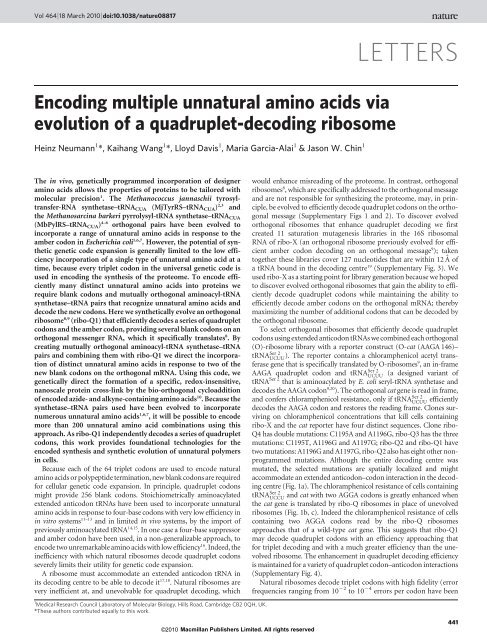

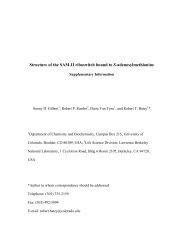
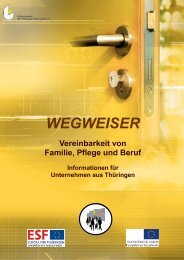
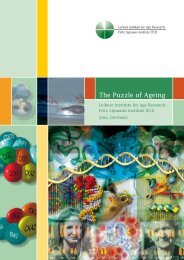

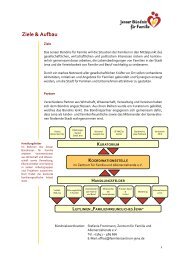



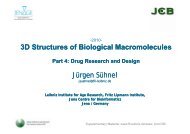
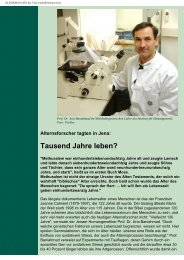

![Programm [pdf]](https://img.yumpu.com/20944039/1/184x260/programm-pdf.jpg?quality=85)
